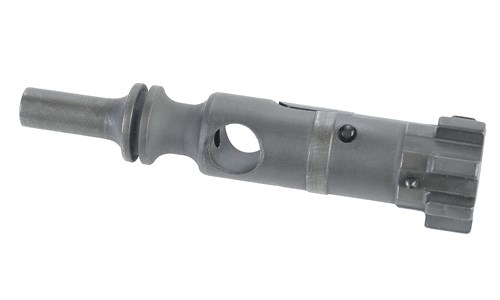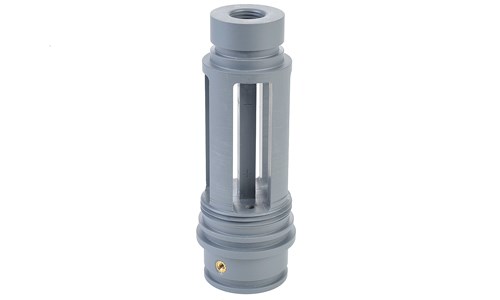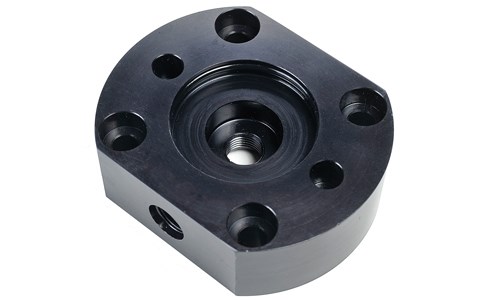Shop Grows its Multitasking Operations
Here's a look at what this shop's expanded multitasking capabilities have meant to its success and how it plans to continue building momentum.
The family-owned company began operations in 1916, serving the screw machine industry with a lineup of cam machines. Today, Nolte Precise Manufacturing (Cincinnati, Ohio) has evolved into a full-service contract manufacturing business, providing medium- to high-volume precision machined and assembled components to original equipment manufacturers while also offering a total supply chain solution with a combination of CNC lathes, mills and Swiss machines alongside its automatic screw machines and assembly processes.
We sat down with Doug Coster, Nolte’s fourth-generation owner and president, to discuss what the company’s expanded capabilities have meant to its success and what he views as the necessary components to continue building momentum.
PM: In which industries does Nolte specialize?
DC: We serve the hydraulics, defense, firearms, aerospace, automotive and instrumentation industries. We do some in the medical industry and would like to grow that industry by obtaining the ISO 13485 certification. Hydraulics and fluid power have been a great fit for us, and that has naturally brought us to other work, including firearms, which has been growing lately.
PM: When did you start implementing multitasking operations in your manufacturing processes?
DC: Multitasking is not a new shift for Nolte. We started with multitasking CNC Swiss machines in the 1990s. In the 2000s, we made significant investments in multitasking machines by adding several Mori Seiki and Eurotech CNC multi-axis lathe machines with multitasking capabilities. We continue to use these machines for medium volume, complex parts, the main advantage being the ability to drop complex parts off complete, eliminating costly secondary operations. We recently continued to expand on that concept with the addition of two Tsugami CNC Swiss machines—an SS26 and BH38.
PM: Why did you feel it was important to grow these capabilities in your shop?
DC: We believe our competitive advantage is our ability to manage more complex parts. We’re able to leverage our capabilities and knowledge to offer a total cost solution that is more defendable in the marketplace. We make bushings and pins, but almost anyone can do that. Much of that work has been off-shored and is less likely to come back, or it is a commodity where the primary purchasing decision is price. This becomes more difficult to defend and differentiate. The more difficult, higher tolerance work requiring higher quality is done a lot closer to home. Other factors come into play as well, such as labor rate, volume and the skill level gap, but not everybody can do these parts. So when we become experts in a certain kind of work, we can offer more value and partnership to our customers.
As a result, we purchase equipment and technology with multitasking capability to drive as much cost out of the processes as possible. Wherever possible, we engineer the process to keep our quality at a very high level, while reducing excess handling and cycle time to control our manufacturing costs.
PM: What factors are considered in determining if a part is appropriate for multitasking operations?
DC: We consider the complexity and volume of the part. Although we’d like to machine all parts complete with one setup, there is obviously a point of diminishing return when the complexity of the part programming and setup costs starts to exceed the processing costs. There can be advantages to breaking the process into simple individual steps to achieve higher throughput.
We established a cell for some very low volume complex parts. This cell has two Doosan Lynx turning centers and a Fanuc Robodrill with a rotary table. The cell is running a variety of parts—about 150 different types, including a lot of plastics.
The multitasking work, on the other hand, is better suited for larger lot sizes or families of parts. The setups come into play in the decision. It’s not only about the capabilities of the machine, but also the bigger picture of the time involved in preparing the job as well as maintaining tolerances. If there’s a lot of GD&T (geometric dimensioning and tolerancing), it’s good to be able to run the part all within the same work center to maintain its orientation. For this reason, how the features relate to one another and how the part should be held to maintain it then becomes the determinant.
PM: So the main advantage of multitasking operations is the ability to drop a part off complete. Do you have other examples of where this has proven beneficial?
DC: We recently took over a product line for a customer that was running it across about 20 different work centers. Each machine did one particular operation. We have it running complete on a single machine, although because of the quantities, we have six identical machines to run the same part. It’s a Feeler VMP-800 vertical machining center with a 30-tool automatic tool changer and 10,000-rpm spindle. It doesn’t matter if it’s Swiss turning, milling, or fourth-axis tombstone, if we can set it up once and take the labor out of it, we’re saving time, saving money, and producing a more consistent quality product.
PM: More complex parts require more knowledgeable operators. What do you do to make sure your machinists are prepared?
DC: This is clearly one of the greatest challenges facing our company and industry. We are fortunate to have knowledgeable staff with diverse experiences and backgrounds. We have four manufacturing engineers on staff who have experience in a lot of different situations. As we prepare for a new project or process improvement, we utilize a team approach to share experiences and knowledge across functions and departments that help us put the right process together for each product.
We also partner with our suppliers to make sure we’re prepared for each new job and to refine our existing processes. REM Sales, from whom we purchased the two Tsugamis, has been a very good partner. They’ve come in and trained our operators on the machines. Those machines were a bit of a departure from our previous CNC Swiss machines and could have presented some challenges in training. Although the mechanics are relatively similar to what our operators were accustomed to, the controller is different. It was critical that we took the time to make sure our personnel were trained properly to operate the new machines, and they did an excellent job with our people.
A lot of our machine tool purchasing decisions are strongly influenced by our relationships with the suppliers. Superior Equipment Solutions has been great to work with as well. In fact, its support on our Eurotechs, RoboDrills, Enshus, and Johnford through the years played a big part in our decision to go back to them for the six Feelers we just purchased.
To prepare for future manufacturing challenges, a critical success factor for us will be how we develop personnel and young talent. We do extensive on-the-job training. To supplement this, we plan to continue to develop additional classroom training and relationships with local tech schools. We currently do some internal training with MasterTask simulation-based online courses. We make a significant effort to spread knowledge to everybody on the floor. That’s really important in helping to grow our company.
It is extremely important for us, and the industry in general, to support machining programs at educational institutions. We need to communicate with these schools to help them understand the skills required for the next generation workforce in manufacturing. We need to support these schools by giving the students of these schools an opportunity to work and gain experience in the industry through co-op programs and job opportunities. We are starting to work with local community colleges and trade schools that have developed programs that educate students in CAD/CAM, CNC programming, and general machining processes, and advance their understanding of blueprints. We try to hire students from these schools when they complete their programs.
PM: What challenges have you faced in timing equipment purchases with new work?
DC: Even beyond training, bringing in new equipment always presents challenges. The sales cycle is long, often taking a year to develop the relationship and understand the customer’s needs and how we will meet them. However, when the time comes to move forward, it seems to always come with an expedited time frame putting tremendous stress on the process of acquiring equipment and evaluating the capability of the process. Making hasty decisions creates downstream processing problems. Again, that is why we believe it is very important to work with true partners. Even though we try to plan and anticipate the risk areas in the process planning stages, it feels like each machine tool purchase comes with some challenge that needs to be addressed. Addressing these issues is much easier when working with a partner.
We felt comfortable with our understanding of the new Feeler 800 machines. We have extensive experience with the controller and other vertical and horizontal machines. However, when they were installed, and we began the process verification, they reacted differently than what we expected. This was a very high profile project and intense time frame. SES and Methods responded immediately and helped us understand the differences and offered suggestions for solutions.
Related Content
Pursuit of Parts Collector Spearheads New Enterprise
While searching for a small parts accumulator for Swiss-type lathes, this machine shop CEO not only found what he was looking for but also discovered how to become a distributor for the unique product.
Read MoreSoftware Controls Chip Breaking in Thread Turning Operations
This cutting tool manufacturer has developed a software module for chip control of thread turning operations in virtually any CNC lathe, even for older machines, using specific tooling and software.
Read MoreCAM-Driven Lathe Questions
There can be hidden issues using legacy cam-driven lathes that can be overcome using new CNC technology. Here are three to keep in mind.
Read More6 Tips for Training on a Swiss-Type Lathe
There are nuances to training a person to effectively operate a Swiss-type lathe. A shop I visited a while back offers some suggestions.
Read MoreRead Next
A Tooling Workshop Worth a Visit
Marubeni Citizen-Cincom’s tooling and accessory workshop offers a chance to learn more about ancillary devices that can boost machining efficiency and capability.
Read MoreDo You Have Single Points of Failure?
Plans need to be in place before a catastrophic event occurs.
Read More5 Aspects of PMTS I Appreciate
The three-day edition of the 2025 Precision Machining Technology Show kicks off at the start of April. I’ll be there, and here are some reasons why.
Read More













.jpg;maxWidth=300;quality=90)

.jpg;maxWidth=300;quality=90)











